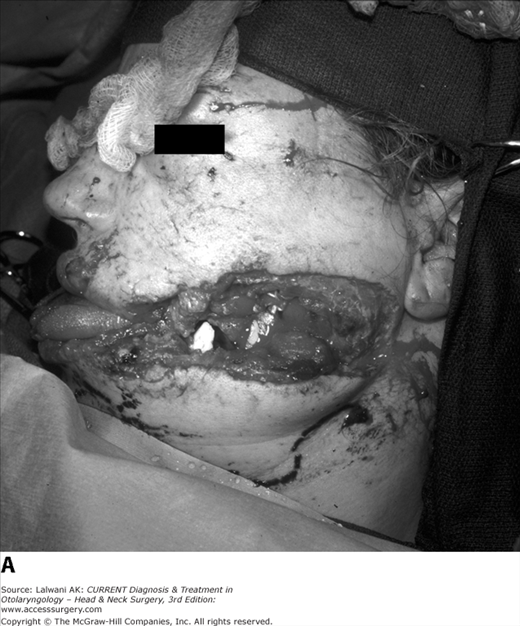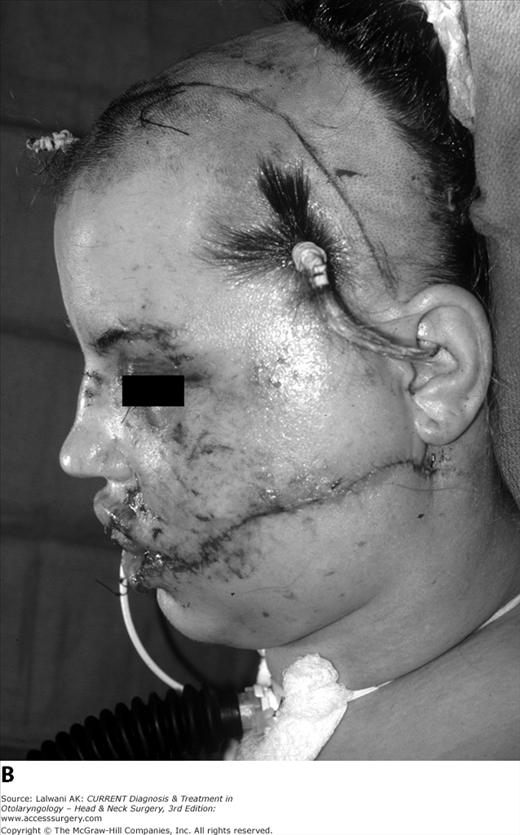Maxillofacial Trauma: Introduction
Patients with maxillofacial trauma are seen everyday in emergency rooms throughout the United States. The cause of the trauma can be quite variable, ranging from industrial and motor vehicle accidents to interpersonal trauma involving either fists or weapons. It is common for trauma to be related to substance abuse or to behavior that can be linked to substance abuse. Sometimes trauma is related to sports activities or simply to accidental or work-related occurrences. The principles of management are directed at stabilizing a patient’s medical condition and providing safe reconstruction to maximize both functional and aesthetic rehabilitation.
It can be disconcerting when a patient is brought into the emergency room with severe craniofacial trauma. Patients may be covered with blood and have distorted anatomy that may divert attention from the initial principles of Advanced Trauma Life Support (ATLS). In these circumstances, it is critically important to follow the basic tenets of initial trauma stabilization, also known as the ABCs of trauma:
- Airway management and assessment
- Breathing
- Circulation
Tamponade of bleeding and C-spine clearance are also critical factors when the patient initially presents to the emergency room. In the initial management period, even occurrences of severe craniofacial trauma may be examined after cases of abdominal, thoracic, and—at times—limb trauma. A neurosurgical examination and clearance are frequently desirable in severe high-velocity injuries. When ocular injury is suspected, an examination by an ophthalmologist can be indispensable. Patients on the most severe end of the injury spectrum often require airway control via orotracheal intubation or, in certain cases, via cricothyroidotomy or tracheotomy.
Most attempts to repair maxillofacial trauma will be considered after the patient is stabilized. Almost all skeletal trauma repair is guided by the information provided by fine-cut computed tomography (CT) scans. Fine-cut scans take more time and require more medical condition stability than the initial screening provided by head and brain CT scans, which are often obtained to rule out suspected neurological injury during the initial, acute evaluation period. In contrast, soft-tissue injuries are often repaired as soon as it is practically possible. Low-velocity injuries, such as isolated nasal and mandible fractures, do not usually require the same highly consultative and collaborative team approach, especially if no other injuries are found or suspected. With isolated injuries, which tend to be more minor than multisystem injuries, treatment can be better directed; it can proceed on a pace both commensurate with and concentrated upon the direct injury.
Soft Tissue Trauma
Although the ABCs of trauma take precedence over most of the issues associated with maxillofacial trauma, sometimes the soft tissue injuries of the face or scalp can add substantially to blood loss. A temporal injury may lacerate the superficial temporal artery or a scalp laceration may contribute to the loss of many units of blood. Under these circumstances, it is desirable to halt bleeding immediately. The discrete clamping of an arterial vessel in a laceration may be necessary if the physician is unable to gain adequate control of blood loss by applying simple pressure. Scalp injuries usually respond to closure with a few simple mattress sutures, placement of staples to approximate the wound, or a pressure dressing. This blood loss management allows time for the rest of the trauma evaluation to proceed and for the patient to be stabilized.
Lacerations of the scalp, face, and neck should be closed as soon as the patient is stable. In cases in which the tissue loss is minimal, which is the most common circumstance, primary closure is utilized. Primary closure is direct edge-to-edge skin approximation using fine sutures with precise suture approximation of deeper tissue layers. Protecting the patient prophylactically with tetanus immunoglobulin and tetanus toxoid should be considered. In contaminated wounds, which are extremely common, prophylactic antibiotic administration should also be considered.
It is important to administer adequate anesthesia for wound closure if the closure is to be made under local sedation. Typically, injectable 1% lidocaine with epinephrine mixed 1:100,000 is adequate to obtain anesthesia for closure. This preparation can be injected with a fine, 27-gauge needle and a control-type syringe. The toxic dose of lidocaine with epinephrine is 7 mg/kg and should be noted. During the procedure, it is often possible to keep the patient comfortable with a small amount of sedation if no contraindication exists. Sometimes topical EMLA cream (lidocaine 2.5% and prilocaine 2.5%) can be used if it is difficult to inject the patient (eg, a child) with a local anesthetic agent.
Once anesthesia takes effect, the wound should be irrigated to help prevent future infection. However, irrigation can only be done effectively if the patient is comfortable. Saline can usually be used to irrigate the wound with a 60-mL syringe. If glass, gravel, or other foreign material is suspected to be in the wound, a finger can be used to probe the wound and remove the foreign material. Sometimes the skin is abraded so badly that the area needing to be anesthetized would be too large to safely administer lidocaine to the patient without causing lidocaine toxicity. In these cases, it is best to proceed to the operating room so that general anesthesia can be administered and the wound can be manipulated without the risk of excessive local anesthesia (Figure 8–1). In some wounds contaminated by tar, as sometimes occurs in motorcycle accidents or other road injuries, administering general anesthesia is the best recommended option for wound manipulation that is comfortable for the patient. Once the wound is thoroughly clean, povidone–iodine, commonly known as Betadine, can be used to create a sterile environment for wound closure. Any small bleeding areas can be handled with a disposable electric cautery, bipolar cautery, or by using individual clamps and suture ties.
Facial wound closure should heal by first-intention (primary) healing whenever possible; lacerations should be closed with direct suturing to approximate skin edges. This closure can be improved with the discrete undermining of skin flaps, where necessary, to produce a tension-free closure. The key elements to obtaining good results with wound closure are (1) having a clean and sterile wound, (2) respecting anatomic boundaries, (3) avoiding tension on the suture line, and (4) having atraumatic surgical technique. The wound should be closed in layers, in the following order: (1) muscle, (2) subcutaneous tissue, (3) subcuticular tissue, and (4) superficial skin. Chromic gut sutures are useful for deep closure; fine nylon or proline stitches are useful for skin closure. Although polyglactin (eg, Vicryl) and polyglycolic acid (eg, Dexon) can also be used for deep stitches, they can sometimes become infected due to sluggish absorption, which can lead to their eventual migration out of the wound. Other dissolvable monofilament sutures may also be used for deep closure. In areas where it is difficult to remove stitches, such as around the eyelid, fast-absorbing 6–0 gut sutures or 6–0 mild chromic sutures can be used. These sutures have the advantage of leaving little trace of their placement and dissolving without requiring removal. These types of stitches may also be useful in children to prevent the need for future stitch removal or when patient follow-up is doubtful. When taking care of patients with heavy beards or dark facial hair, it is best to use a skin suture color other than black to facilitate future removal. Blue proline suture works well in these circumstances.
If wound coverage is difficult because of lost skin, transposition flaps can be used to create closure. However, these flaps are rarely necessary. If they are required, it is often best to accomplish the closure in the operating room setting as instrument sets and nursing assistance become more critical. The risk in using transposition flaps is that the wound is usually contaminated; utilizing these flaps may increase the risk of tissue loss if the wound becomes infected. In these cases, wounds may be allowed to heal by second-intention (secondary) healing through the granulation and contracture process with a subsequent plan, if necessary, for wound revision.
A special circumstance of trauma involves bite injuries, which may be of animal, insect, or human origin. Allowing a bite injury to heal by first-intention healing should be considered carefully because the wound is likely to be contaminated. Although infection may ensue, primary closure is still recommended for these wounds after thorough irrigation and with concomitant antibiotic administration. The antibiotic coverage should be directed at a polymicrobial spectrum, including α-hemolytic streptococci, Staphylococcus aureus, and anaerobes such as Bacteroides. β-lactamase stable antibiotics such as amoxicillin–clavulanic acid combination drugs are good targeted medications for prophylaxis of these types of injuries. It is likely that the result will be no worse if an attempt at closure is made, even if the wound eventually becomes infected compared with leaving the wound open to heal by second intention.
Burn Management of the Head and Neck
During the acute management of patients with facial burns, the fundamental principles of trauma are followed. Special attention must be directed to evaluation of the airway because airway obstruction may develop rapidly after inhalation injury. Delayed onset of obstruction within 24–48 hours may occur from progressive edema. Specific risk factors for airway compromise include a history of burn injury within a confined space, evidence of soot in the oral cavity, production of carbonaceous sputum, and concomitant facial and body burns. Laboratory evidence, including arterial blood gases and carboxyhemoglobin levels, may further suggest potential airway impairment. If time permits, serial flexible fiberoptic nasolaryngoscopy exams allow for diagnosis of oropharyngeal, true and false vocal fold edema. In management of burn patients, there should be a low threshold for early intubation.
Burns are broadly classified according to depth of penetration. First-degree burns involve the epidermis only (eg, sunburn), and clinical findings include erythema. Second-degree or partial-thickness burns involve the epidermis and a portion of the dermis. These burns are extremely painful and present with blistering and open, weeping surfaces of skin. Third-degree or full-thickness burns represent involvement of all layers of skin, including nerve endings, blood vessels, and skin appendages. As such, they are characterized as insensate, swollen, and white or gray in color. Extent of burn injury is estimated by the “rule of nines,” whereby the head and neck region represents approximately 9% of total body surface area.
Inpatient management is universally required for second- or third-degree burns of the face. Early treatment goals involve the prevention of infection via sterile dressings, burn excision, and wound closure if permissible. To attenuate contracture and scar formation, temporary wound cover may be accomplished with cadaver grafts, porcine grafts, and a variety of synthetic skin substitutes. Permanent wound coverage is obtained by split-thickness skin grafts, local flaps, or microvascular free tissue transfer. Microstomia commonly results from perioral facial burns, or thermal burns that occur when small children chew electric cords. Oral splints are available for prevention of microstomia, but the efficacy of these appliances is controversial. Contracture of the eyelid, or ectropion, occurs when the eyelids are everted from the globes following burn injury. Early ophthalmologic consultation is recommended. To prevent corneal damage, early reestablishment of lid position is imperative.





